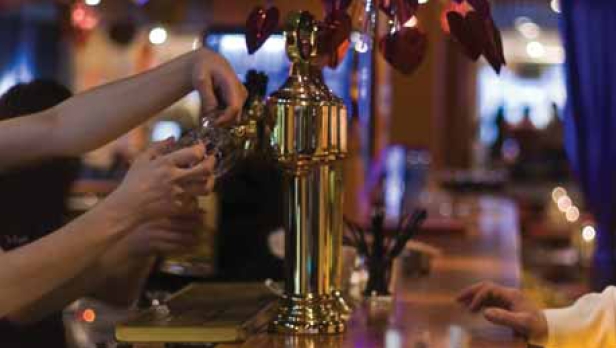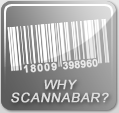News Articles

When Alberta-based Cowboys opened its first location in Calgary in the late 1990s, the bar was packed to the gills every night. Amazingly, despite the wall to wall revelers, the popular club was somehow still failing to turn a profit.
At that point, it was clearly time to figure out what was going on says Paul Vickers, president of the Cowboys chain. After an exhaustive review of the business, an internal audit determined that one of thekey problems was that each of the bar’s service staff was, on average, handing out one or two free drinks per shift.
While that may seem like small potatoes, once all the employees and all the shifts were added up, the loss to Cowboys was a staggering $3.8 million per year. Obviously, even small scale pilfering can have a huge cumulative effect in a busy operation, particularly in a business with multiple locations.
At the time, Cowboys was manually marking bottles and weighing their liquor as their primary method of inventory control. It was an arduous and time consuming process that was still not getting the job done.
Knowing they needed some help, Vickers turned to Montreal’s Scannabar. Scannabar’s Roberto Scanga explains that his company’s system, “helps a hospitality operator manage their liquid assets the moment they are received in the establishment until the day they are emptied and recycled. Scannabar gives the operator the ability to check and balance what is being received, track what is being transferred and quickly and accurately quantify usage at each of their pouring stations, thus keeping bar staff accountable.
”The system is very straight forward. Once a liquor delivery is made, all bottles have a bar-coded ribbon affixed to the exterior of the bottle. By scanning both the Scannabar bar code and the existing bar code on the bottle, the system is able to calibrate each bottle individually from the bottom to the top. The bar-coded ribbon is used as a measuring tool and designed to sustain all the harsh elements found in a typical bar, including ice bins, speed rails and coolers.
For those looking to put a tight control on inventory, Scanga explains that Scannabar is, “the only product in the market that offers individualized bottle tracking by way of a serialized label that tracks every bottle from the receiving point to an unlimited number ofpouring stations and not only makes the ounce accountable, but also the bottle.
 ”Another system well worth investigation by bar operators looking to stay astep ahead of those looking to rob them blind is the AZ-200 from Azbar, another Montreal-based company.
”Another system well worth investigation by bar operators looking to stay astep ahead of those looking to rob them blind is the AZ-200 from Azbar, another Montreal-based company.
Sam Uva, president of Dynamic Hospitality & Entertainment Group, a companythat includes Toronto clubs Seven Lounge and Berlin among its interests, says that after a great deal of research, the AZ-200 was chosen because it best addressed the issue of liquor shrinkage.
The AZ-200 control unit, which can be used with programmable pourers, a cocktail tower, a draft beer head, a wine dispenser, a liquor gun, and inline flow meters, offers bar operators one-stop shopping for their liquor control problems.
The easy to use system automatically tallies each transaction between a bar’s staff and their customers, then updates the bar’s inventory in real time. It avoids waste by always pouring exact portions and a seal prevents dilution of bottle contents.
For the owner who likes to keep a close eye on their operation while not on the premises, the system allows for modem-based remote control monitoring.For those with security on the mind, that means the ability to check out what is happening at their bar from anywhere inthe world with an internet connection.
For Uva, as it should be for all operators, the bottom line is the determining factor of success. He estimates that prior to signing on with Azbar, the liquour shrinkage at his locations was in the vicinity of 22% to 23%. With the AZ-200, he figures that number has dropped down to 16%, an impressive savings that makes the return, on the considerable investment of implementing the system,well worth it over the long run.
Systems like those from Scannabar, Azbar and a multitude of other companies specializing in loss prevention software, make a lot of sense for medium to large operations that employ a lot of staff.
However, for cozier neighbourhood bars and small family-run operations,something as simple as a dependable pour can make a big difference.
Michael Billard, owner of the Elrose Tavern, in Elrose, Saskatchewan, is a big fan of the pours he buys from Precision Pours, Inc. They look and handle just like a non-measured pour and they save bartenders precious time by allowing them to pour liquor and mix at the same time, eliminating the need for shot glasses or jiggers.
With these simple pieces of equipment, bars can eliminate overpouring and spillage, saving the operator a lot of money in the process. After a lifetime in the hospitality business, Billard doubts even he can pour an exact one ounce shot. And if he can’t do it, he doubts many bartenders or servers can do it either.
Rick Sandvik, president of Precision Pours, estimates two to three drinks are lost per bottle at locations that encourage free-pouring, a number Billard agrees is just about right. If an establishment charges $5 per drink, the loss is $10 to $15 per bottle or $120 to $180 per 12-bottle case. Unless addressed, that money is coming out of the pocket of the bar owner and will never be recouped.
Considering the durable and easy to maintain pours from Precision Pours cost roughly $5 each, the return on investment does not take much time to realize, particularly when bought in bulk at a slight discount.
Billard also points out that by using the dependable pours, his customers can always count on receiving a drink that consistently tastes the same. When the customer trusts that they are getting what they have paid for, it builds increased customer loyalty.
Further to that, Billard speculates that bartenders that overpour are ultimately costing themselves money. When the beverages a bar patron receives are stronger than expected, it is natural that most would consume fewer drinks, resulting in a lower total bill and subsequently, a lower tip for the bartender.
Philippe Blouin, vice-presidentof sales at Azbar, says their system will always pour the exact drink that is ordered. If customers have any issue with the taste of a particular drink, then the operator knows it is the recipe they are using and not different bartenders using different ingredients.
Regardless of the system a bar has in place to prevent liquor losses, Vickers says it is imperative that management be vigilant in watching what is happening on the premises. He compares his onsite managers to Las Vegas pit bosses, pointing out that their roles are very similar.
In Vegas, pit bosses are tasked with being the casino’s eyes and ears in the trenches. They are looking for any suspicious behaviour from both the dealers and the gamblers. They are also responsible for signing over chips, representing huge sums of money, to the dealers.
In a bar, Vickers says it is pretty much the same process. As former bartenders and servers themselves, the managers at Cowboys know every trick in the book. Whether it is sneaking in a bottle to sell off the books, or adding too much ice to a tray of shooters to water them down, they must be on the lookout for potential scams at all times.
 With over 20 years in the bar biz, Uva feels an operator has to have a basic understanding of human psychology to be successful. He refers to the 80-10-10 principle as an example ofthis. Of 100 random people that could potentially work in one of his bars, he estimates 10 will always steal when given the chance; 10 will never steal under any circumstances; and 80 are opportunists that could go either way depending on the situation.With this in mind, he figures that introducing measures that make stealing extremely difficult, should help to keep the group of 80 on the straight and narrow.
With over 20 years in the bar biz, Uva feels an operator has to have a basic understanding of human psychology to be successful. He refers to the 80-10-10 principle as an example ofthis. Of 100 random people that could potentially work in one of his bars, he estimates 10 will always steal when given the chance; 10 will never steal under any circumstances; and 80 are opportunists that could go either way depending on the situation.With this in mind, he figures that introducing measures that make stealing extremely difficult, should help to keep the group of 80 on the straight and narrow.
Cameras are popping up in more and more bars as an attempt to provide added security. While these can be very helpful as a general deterrent, Uva is not sure theyare that helpful in the end. “The resolution on those cameras is terrible and to be honest, who has the time to watch through hours of surveillance tape anyway?” he asks.
A better technique he suggests is to have managers look through the sales reports of staff looking for questionable patterns.He recalls a few years back at one of his clubs, a bartender who took advantage of a two-ounce Vodka-Cranberry special. A single drink would sell for $5, while the double would sell for the reduced price of $6.95. If a patron were to come to the bar and order two single Vodka-Sodas, the bartender would provide the drinks and charge $10, but would then turn around and input the two vodka shots into the POS system as the Vodka-Cranberry special for $6.95, pocketing the extra $3.05 every time that transaction came up.
Had this bartender not overdone it on the scam, it could have gone on for a while. However, when she got too greedy, her sales reports showed an inordinate number of the Vodka-Cranberry specials being sold as compared to the bar’s other employees. A manager going over the reports noticed the pattern and was quickly able to figure out what the cheating bartender was up to.
Memo Degirmenoglu, beverage manager at Montreal’s Sir Winston Churchill Pub, uses the full Azbar package at the popular Crescent St. hotspot. He appreciates the inventory controls built into the software, as well as the varied and detailed reports that can be generated from the system.
While the system helps him to keep on top of the liquor shrinkage issue at the sprawling, three-level bar, he also suggests using “mystery shoppers” as a means of identifying potential problems. Bartenders will often let their guard down around customers, openly mocking a bar’s management. Mystery shoppers with a keen eye can quickly ascertain any bar protocols that are being compromised and alert management to areas that need to have tighter controls.
In the bar business, time is money. With most loss prevention systems now of the high tech variety, it is extremely important that the company that sold the system be ready to provide instant support in the event of a problem. When dealing with a vendor, bar operators need to know they can trust that vendor to be there for them in the event of an emergency. With Scannabar and Azbar, most problems can be resolved online. However, if the issue is of a more serious nature, then it is equally important that an actual technician be dispatched to the locations as soon as is humanly possible.
Vickers knows the Scannabar system has never given Cowboys any major issues. He credits the company’s initial installation of the system, coupled with their training program as the reason for this. Had there ever been any huge problems, they would have made it to his desk in the president’s office. And since that has never happened, he feels very comfortable giving the company the thumbs up on customer support.
Another factor that bar operators look for in a loss prevention system is simplicity for staff. The more time spent on training staff is less time that staff is actually on the floor generating sales.
Spiro Peterson, assistant manager at Moe’s Deli & Bar in Pointe Claire, Quebec, has worked with both Scannabar and Azbar and says both are easy to use, resulting in minimal time spent on training. With staff turnover continuing to be a big issue in the bar business across the country, anything that contributes to employees wanting to stick around is a big plus.
By being vigilant in the battle to reduce liquor losses, savvy owners and operators can count on having more of their hard earned cash in the till at the end of everynight. For Vickers, the savings realized since the transition to Scannabar means more capital to keep his clubs popular. “Most bars last six months to two years. At Cowboys, we’ve been around for over 10 years because we invest back into our locations.” He adds that, “We spend money on promotions, on bringing in bands and making constant renovations to keep our places looking fresh.”
With drinks flying over the bar at Cowboys on a busy Saturday night, it is clear that there is plenty of money to be made by both the bar itself and the staff busting their tails working at the hopping joint.
And while the relationship between bar staff and management can often be a frosty and confrontational one, it does not have to be. If operators and staff can create an atmosphere that encourages patrons to open up their wallets, enough money will be made to keep everybody content.
With the proper loss prevention system in place, bar operators and staff can focus less time and energy on trying to outsmart one another and more on serving their customers. Because at the end of the day, improving the experience for every patron that walks through the door will keep those customers coming back again and again. And that is a goodresult for everybody involved.






